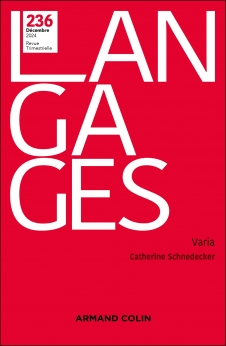
LANGAGES N° 236 (4/2024)
Pour acheter ce numéro, contactez-nous
Recevez les numéros de l'année en cours et accédez à l'intégralité des articles en ligne.
On part d’une conception des référents comme interprétants cognitifs des désignateurs linguistiques. La valeur référentielle des pronoms clitiques du français apparaît sujette à variation. Ils marquent concurremment soit le trait [±animé] d’un référent, soit son caractère [±déterminé] (c.-à-d. le fait qu’il a été ou non catégorisé et particularisé). L’emploi d’un pronom est plus ou moins optimal, selon qu’il dénote conformément à sa valeur sur ces deux axes, ou seulement sur l’un d’entre eux. Par ailleurs, il peut y avoir discordance entre les traits attribués à un dénoté par un pronom clitique et par un NP coréférentiel, ce qui produit deux sortes d’effets interprétatifs : le dédoublement du référent (‹objet indiscret›) ou sa dé-personnification.
We start from a conception of referents as cognitive entities which are the interpretants of linguistic designators. The referential value of French clitic pronouns appears subject to variation. They concurrently mark either the characteristik [±determined] of their referent (i.e. whether it has been categorized and particularized or not), or its feature [±animated]. The use of a pronoun is more or less optimal depending on whether it denotes in accordance with its value on these two axes, or only on one of them. Furthermore, there can be a discrepancy between the features attributed to a referent by a clitic pronoun and by a co-referential NP, which produces two kinds of interpretative effects: the splitting of the referent (non-discrete object), or its de-personification.
